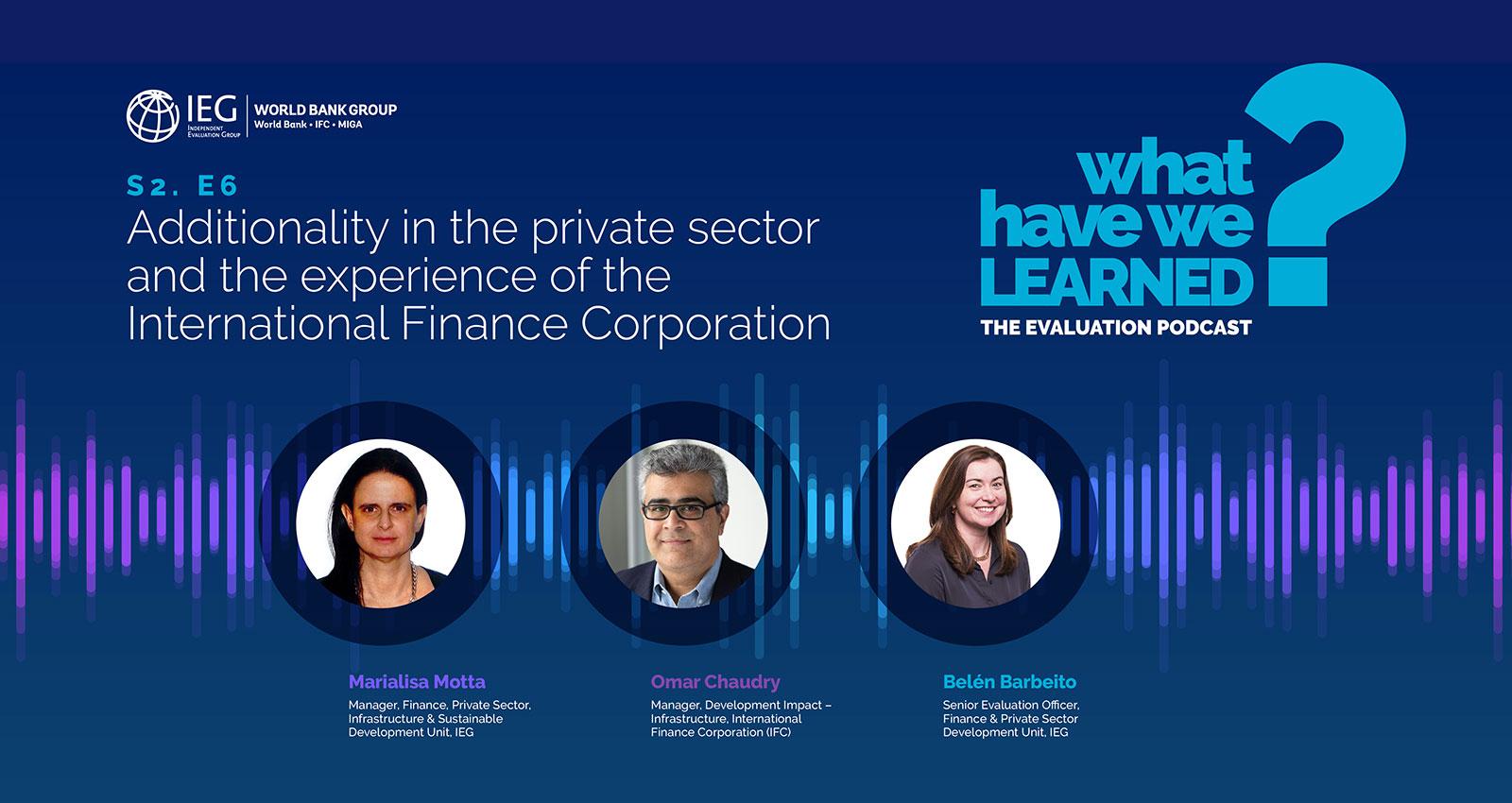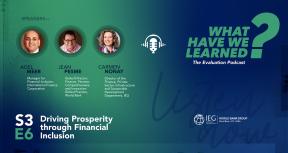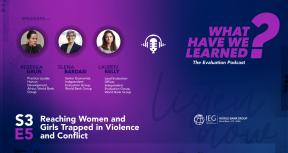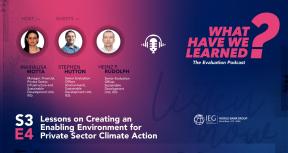Additionality is the unique value that Development Finance Institutions (DFIs) offer to private companies in low- and middle-income countries without crowding out private investments. For DFIs, such as the International Finance Corporation (IFC), the private-sector arm of the World Bank Group, additionality is a core feature of its investments. Yet, it comes with many challenges. Additionality is often difficult to identify, measure, and realize.
The Independent Evaluation Group (IEG) recently published a report that examines the approach of IFC to additionality in middle income countries. IFC is the largest provider of development finance for the private sector across all developing countries, and it has been a leader among DFIs in identifying and articulating additionality for projects. Insights from IFC’s experience with additionality offers valuable lessons for both its and other DFI’s future investments in the private sector.
In this episode, Belen Barbeito, a co-author of the IEG report and Omar Chaudry, the Manager of the Development Impact – Infrastructure unit in IFC, join Marialisa Motta, manager in the Finance, Private Sector, Infrastructure, and Sustainable Development department of IEG to demystify additionality, and discuss IFC’s experience with identifying and measuring it, and the possibility of realizing ever more of its unique value going forward.
Listen on Spotify, or Apple Podcasts.
Related Resources
- Evaluation: International Finance Corporation Additionality in Middle-Income Countries: An Independent Evaluation
- Blog: Exploring how and why the International Finance Corporation investment projects make a unique contribution in middle-income countries
- Blog: What next for additionality: promoting better understanding of its role in development
TRANSCRIPT
“So, the way we have looked at additionality at IFC, is the unique support that we bring to an investment project, and that one which is not offered by commercial sources of finance.”
Marialisa:
Additionality is a defining feature of development financial institutions, and at the same time it is a bit of a thorn in their side. What is additionality? Additionality is the unique value that development financial institutions offer to private companies in emerging markets and poor countries, which these companies would not get from commercial banks. It's a special tool that development banks can deploy to jumpstart and accelerate private sector growth, in turn creating jobs and wealth in developing countries.
The definition of additionality is a bit elusive, as it is often hard to identify and measure the unique value that development banks can provide. And because of this, additionality has become the source of much debate in the development community.
Is a loan provided by the IFC, the International Finance Corporation, the private sector arm of the World Bank Group, really different from a loan provided by a commercial bank?
Could the wheat grower in the East of Turkey have gotten a seven years loan from a local bank, to buy its harvesting equipment without the involvement of the IFC? How do we know? How does additionality manifest itself? How do we measure it?
Welcome to What Have We Learned? The Evaluation podcast. I'm your host, Marialisa Motta, a manager in IEG, the Independent Evaluation Group of the World Bank Group. In this episode, we will try to answer some of the questions above. We will try to catch elusive additionality, measure it, and demystify a bit. We will do so on the basis of the findings of a recently published IEG evaluation, titled IFC Additionality in Middle Income Countries, and also on the basis of IFC's firsthand experience with additionality on the ground. For this, I'm joined today by Belen Barbeito, a co-lead of the IEG report on IFC Financial additionality, and by Omar Chaudry, the manager of IFC development impact for infrastructure.
IFC is the largest provider of development finance for the private sector across all developing countries. So we hope that insights from this discussion will offer valuable lessons for other development financial institutions, and for the development community around the world.
Buongiorno, Belen. Buongiorno, Omar. And welcome to What Have We Learned?
Let me begin with you, Belen. Are all types of additionality the same? And what are some of the challenges when it comes to identifying and measuring the various aspects of additionality?
Belen:
Thank you, Marialisa, not all additionalities are the same. We have two main types of additionality, what we call the financial additionality and what we call the non financial additionality. Financial additionality is based on the ability of the IFC to bring financing that is not available in the market, it could be based for instance, on the financing of IFC being of longer term that is offered or offering in that local currency which is not available. Or it could also be that the financing is innovative, the financing structure is innovative. For instance, green bonds and derivatives and is hasn't been yet present in the country. So, finance additionality actually makes the project happen. On the other hand, we have non-financial additionality.
Non-financial additionality is all about deployment of knowledge and expertise to help the client for instance, improve standards, meet certain standards – in the IFC, it is very common to do environmental and social and governance standards - or also to address issues of capacity in the client. So, there's a lot of hands-on capacity building support, that's another type of additionality.
Financial additionality is usually realized at the time the funds are disbursed versus non-financial additionality, which needs to be deployed over the project life by the institution, it needs to be delivered by the institution. And for that they need to plan ahead, think about how they're going to deliver this expertise and these hands-on support to the client and they need to allocate resources to make sure that happens.
Marialisa: Many thanks, Belen. This really helps to start uncovering some veils.
Let me now turn to you, Omar. How has IFC approached the challenge of identifying and measuring additionality? And what type of additionality has IFC found to be most important in middle income countries?
Omar:
Thank you, Marialisa. So, the way we have looked at additionality at IFC, is the unique support that we bring to an investment project, and that one which is not offered by commercial sources of finance. It's also important I think to note that additionality is a threshold condition for IFC involvement in a project. It's not a policy, it's not an objective, but rather it is a requirement which is embedded in IFC's articles of agreement.
And while the basic concept of additionality has not changed, for those of us who've been involved in this area over the last several years, the way we assess and articulate additionality has undergone quite a bit of change.
The IFC has taken several steps to build a much more robust additionality system. The framework as we like to call it, was revised in 2018 following a process in which IFC co-led a multi MDB task force on the subject. Now, over time, IFC's value addition or additionality to clients, much like those of other MDBs, has become much, much broader to include both financial and non-financial attributes. As capital becomes more available in emerging markets, or at least that was the direction of travel till the start of 2020, IFC support on non-financial matters has become more prominent, while in higher risk developing markets, our traditional financial additionality continues to remain the key driver of our engagement.
Turning very quickly now to middle income countries. We see a mix of financial and non-financial additionality, and this has come out in the report that Belen had co-led. And to be very frank, I think this is one area where the report was very, very useful for us and has prompted a fair bit of internal discussion already at IFC. Although the availability of capital is indeed much greater in MICs as compared to low-income countries, which a priori may lead us to the conclusion that non-financial additionality would be dominant in these geographies. The fact of the matter is that financing needs continue to far exceed supply, particularly in areas such as climate where mobilization of capital can be quite challenging. And also, in a world of intensifying crisis and global challenges including those that the World Bank Group going forward will seek to address as part of the evolution roadmap, the financing needs to address these will continue to remain very, very large, including in middle income countries where financial sectors may not have the capacity to meet those needs.
Marialisa:
Thank you, Omar. Thanks for clarifying that additionality is a threshold condition, it's either there or not, and that is important to make a difference and to achieve impact in IFC client countries. Now, Belen, Omar mentioned non-financial additionality. The recent IEG report outlines some significant potential for realizing non-financial additionality in middle income countries. Could you outline some of these opportunities and what stands in their way?
Belen:
Sure. An important finding of this report is that it confirmed the positive relationship between additionality and the likelihood of a project achieving development results, development outcomes. This relationship is even more pronounced in the case of non-financial additionality. For instance, projects realizing knowledge and capacity building type of additionality are 20% more likely to have positive development outcome ratings. Similarly, projects that realize a standard setting type of additionality are 20% more likely to have positive social and environmental outcomes. In addition to this, as noted by Omar, what we have observed is that over time IFC has increased its offering of non-financial additionality. In the past, IFC portfolio was mostly relying on financial additionality claims. As time passed over the years, we see an increase of a combination of financial and non-financial additionalities being offered by IFC.
Despite these two points, the evaluation realized that IFC had challenges when it came to realizing or delivering the non-financial additionality promises. The difficulty lies in the fact that financial additionality is usually realized at the time of project approval, once the funds asked are dispersed. Versus non-financial additionality, which is usually realized over time over the project life. And it requires proactive management of IFC. Just to give you an example, IFC is regarded as a leader in its ability to help the clients achieve environmental, social, and governance standards. This is a type of non-financial additionality. And it achieves this, because it devotes substantial resources, human non-financial resources, not only to monitor compliance by the clients, but also to help the clients get to the level of meeting those standards.
So, there's a lot of hands-on support, there's a lot of hand holding. So, in order to increase its realization of non-financial additionality, IFC needs to plan ahead. It needs to think through what is needed in order to deliver that support over the project life. It also needs to monitor, make sure that this support is delivered during project implementation, and all the resources have been allocated and available for that support to be implemented. And finally, it needs to assess whether at the project end, IFC was able to fulfill its non-additionality promises. So planning and monitoring non-financial additionality will go a long way in order to be able to increase the realization rates of this type of support.
Marialisa:
Many thanks, Belen. Omar, from your perspective, from the IFC on the ground, how do you see the potential in non-financial additionality, and what do you think it would take to realize it fully?
Omar:
So there is clearly tremendous potential and I've many reasons for this, but two in particular that come to mind immediately. First, we find that in some sectors and in some geographies, not withstanding the effects of the pandemic, we are working with clients that value us more for how we can potentially help them transform into more sophisticated players, as opposed to help them gain access to finance which may not be available locally. Second, and this should not be surprising, is that with the global development financing landscape evolving and growing so much over recent years, one of the facts that we observe is that there is a lot of heterogeneity in the global development financing landscape.
And this I think is extremely important because non-financial additionality of the type that companies are expecting from players in the financing landscape in emerging markets, can only be provided by a handful of such players. Making the role of institutions like IFC as well as some other MDBs really critical in this space. So with that broader context, let me get a little bit into what we mean by non-financial additionality. non-financial additionality covers a very broad swath of value add that IFC and other MDBs can bring to the table.
Involvement in a particular project could be designed explicitly to catalyze an investment response to a change in the policy or the regulatory framework. Or there could be the provision of expertise, innovation, knowledge or capabilities that are material to the realization of a project, and a project's impact in particular, due to the perceptions of weak institutional capacity related to the borrower, or to the investee that IFC works in. And last, the value add could also be in the area of environmental and social standards, and in corporate governance, or specifically in jurisdictions where laws and established market practices do not reinforce this behavior.
What will it take to realize non-financial additionality fully? So this is the million-dollar question that we're also asking ourselves, especially after the recent report, which has really prompted a fair bit of thinking and rethinking. The first point I'll make is it takes two to tango. While we can and we often do bring the expertise to deliver in the areas that I've just noted, we will need clients that we work with to demonstrate a sustained commitment and willingness to engage. On our side, we will need to invest much more time and much more effort in staying on top of what we promised. And this is the point that Belen was also talking about earlier. And how much of that did we actually deliver? Therefore, establishing a much more robust system of exposed monitoring of additionality, or realized additionality as the report calls it, is something that we're currently in the process of working through.
Marialisa:
Many thanks, Omar. It is pretty clear from what you and Belen said that non-financial additionality is as important as, if not more important than financial additionality, and so is the combination of the two. Finally, Belen, we have focused so far on additionality at the project level. Could additionality also be a useful guide for IFC's engagement at the sector level, take for example renewable energy, or for guiding strategy at the country level?
Belen:
Indeed. As mentioned by Omar additionality is treated in IFC at the project level, it's a threshold condition for approving our project. Hence IFC's additionality framework and the related internal systems were conceived to describe and capture additionality at the project level. However, we believe that this narrow view misses an opportunity to identify and increase the distinctive value add that IFC might be able to deliver in a specific sector in a specific country. Actually, the evaluation found positive examples of this beyond the project additionality. IFC's intervention in a nation, country, in a specific sector was recognized by the stakeholders in that sector as being catalytic for the development of that sector. In that case, IFC engaged early on, in the nascent stages of the sector, it stayed in long-term commitment with the stakeholders and private sector clients and government, and it deployed all types of support from different tools that it adjusted over time as the market matured.
Hence, to achieve beyond the project additionality, we believe it requires a strategic approach, a strategic thinking. It requires IFC to think long-term, to have a long-term vision of what it wants to achieve in a specific sector and country. It's not about approving a project but thinking about how the combined additionality of all the interventions in that country over a long period of time will actually contribute to a sector or country level additionality. It needs also to sequence therefore its interventions and coordinate as well and compliment the work by other development finance institution, to ensure not only that there are no overlaps, but that everyone is actually pushing the sector in the same direction. This strategic thinking, we believe, will be greatly facilitated if IFC explicitly discussed and considered additionality in its country and sector strategies, rather than do it on an ad hoc basis.
Marialisa:
Many thanks, Belen. And last word to you, Omar. How do you see the potential for looking beyond additionality in individual projects and what are some of the changes that might be needed?
Omar:
One of the features of our overall approach in this area that has remained constant is the lens through which we capture and realize additionality, which as Belen also noted is the project level. And this is not just us, it's an approach that is shared by other MDBs. Having said that, there is nothing to prevent us, especially now that we have the benefit of some very useful findings from this report, to explore how project level additionality considerations can explicitly inform both country and sector level engagement where it is feasible. As our approach to share assessing strategic priorities as well as engagements in countries at the level of the country, is based on a number of different factors, which includes development needs, comparative advantage, but also our ability to bring to the table what others cannot, which is our role and our value added.
It is also worth noting that as part of the World Bank Group's country partnership framework mechanism, this provides the authorizing context, if you will, for IFC operations at a country level. And this can enhance value add both at the country and at the sector level. Taken together with the IFC 3.0 toolkit, as we all know it by now, which includes analytical work such as country private sector diagnostics, the country climate development reports, the whole gamut of upstream activities that we launched a few years ago and are continuing to be engaged in, has really created in my view a step change. And it provides a strong basis for joint as well as sequenced World Bank Group activities, enhancing our overall value and delivery to the clients that we work with. A stronger focus on the One World Bank Group approach and the cascade, especially as it's now identified in the evolution roadmap, will no doubt support greater impact, but also greater value add and greater additionality from IFC.
Marialisa:
Many thanks, Omar. So, identifying additionality at the sector and country level seems to be the next frontier, which might open up interesting opportunities to further accelerate private sector growth, create jobs, and increase wealth in emerging markets.
Many thanks to both of you, Belen and Omar, for joining me today. It has been a fascinating conversation. To learn more about IEG's recent work on evaluating the IFC approach to additionality middle income countries, please visit ieg.worldbank.org. And don't forget to subscribe for future podcasts. This has been What Have We Learned, The evaluation podcast. Thank you for listening and arrivederci.
This Episode’s Featured Guests:



Omar is a Manager in IFC’s Development Impact Department. In this role, Omar oversees a multidisciplinary team of professionals across 4 continents – managing a diverse portfolio of activities. These include (i) impact assessment & monitoring - via the deployment of IFC’s AIMM system for investment and advisory operations, as well as continued oversight for its ongoing implementation; (ii) development and rollout of IFC’s renewed approach to additionality; (iii) strategy for infrastructure – via a multifaceted approach to the scale up of solutions in emerging markets; and (iv) convening for IFC in the infrastructure space, within the MDB/DFI community, as well as representation on global fora including the G20. Omar has been with the World Bank Group since 2000 in a variety of regional and sector- focused roles, and is based in Washington DC.






